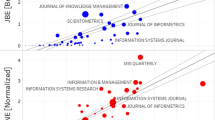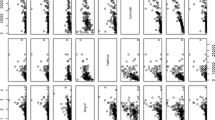Abstract
The literature considers a journal’s h-index as a compared measure, however the relation between institutional level h-index (IHI) and journal related indices (JRI) has not been explored in previous studies at meso-level research assessment. This study applies the scientometric approach to meso-level data to examine the association, functional relationship and correlation analysis to evaluate the reliability of IHI with respect to JRI. For this purpose, data from the Web of Science, journal citation report and time cited features were used. The unit of analysis was Malaysian engineering research with a wider time span of 10 year’s data (2001–2010) and a larger set of journals (1381). We explored the inter-correlation of IHI with a set of eight JRI and applied principle component analysis, regression analysis, and correlation. At the institutional level, the component analysis and functional relationship of the cumulative impact factor and 5 years IF yielded a more strong association with IHI. Cumulative impact factor is a strong predictor for IHI followed by cumulative 5 years impact factor. Correlation matrix results show that average impact factor (AIF) is correlated with immediacy index and Eigenfactor only. AIF and median impact factor (MIF) have no correlation with each other and IHI is correlated with all indices except AIF and MIF. This study puts forward a better understanding in considering new impact indices at meso level for performance evaluation purpose.


Similar content being viewed by others
References
Abrizah, A., Zainab, A. N., Kiran, K., & Raj, R. G. (2013). LIS journals scientific impact and subject categorization: A comparison between Web of Science and scopus. Scientometrics, 94(1), 721–740.
Amin, M., & Mabe, M. (2000). Impact factor: Use and abuse. Perspectives in Publishing, 1, 1–6.
Bador, P., & Lafouge, T. (2010). Comparative analysis between impact factor and h-index for pharmacology and psychiatry journals. Scientometrics, 84(1), 65–67.
Bergstrom, C. (2007). Eigenfactor: Measuring the value and prestige of scholarly journals. College & Research Libraries News, 68(5), 314–316.
Bornmann, L., Marx, W., Gasparyan, A. Y., & Kitas, G. D. (2012). Diversity value and limitations of the journal impact factor and alternative metrics. Rheumatology International, 32, 1861–1867.
Bornmann, L., Mutz, R., & Daniel, H. D. (2008). Are there better indices for evaluation purposes than the h-index? A comparison of nine different variants of the h- index using data from biomedicine. Journal of the American Society for Information Science and Technology, 59(5), 830–837.
Bornmann, L., Mutz, R., & Daniel, H. D. (2009). Do we need the h-index and its variants in addition to standard bibliometric measures? Journal of the American Society for Information Science and Technology, 60(6), 1286–1289.
Bornmann, L., Mutz, R., Hug, S. E., & Daniel, H. D. (2011). A multilevel meta-analysis of studies reporting correlations between the h index and 37 different h index variants. Journal of Informetrics, 5(3), 346–359.
Braun, T., Glänzel, W., & Schubert, A. (2005). A Hirsch-type index for journals. The Scientist, 19(22), 8.
Braun, T., Glänzel, W., & Schubert, A. (2006). A Hirsch-type index for journals. Scientometrics, 69(1), 169–173.
Conway, J. M., & Huffcutt, A. (2003). A review and evaluation of exploratory factor analysis practices in organizational research. Organizational Research Methods, 6(2), 147–168.
Costas, R., & Bordons, M. (2007). The h-index: Advantages, limitations and its relation with other bibliometric indicators at the micro-level. Journal of Informetrics, 1(3), 193–203.
Gavel, Y., & Iselid, L. (2008). Web of Science and scopus: A journal title overlap study. Online Information Review, 32(1), 8–21.
Harzing, A.-W., & Van der Wal, R. (2009). A google scholar h-index for journals: An alternative metric to measure journal impact in economics and business? Journal of the American Society for Information Science and Technology, 60(1), 41–46.
Hatcher, L. (1994). A step-by-step approach to using the SAS system for factor analysis and structural equation modeling. Cary, NC: SAS Institute Inc.
Hicks, D., & Wang, J. (2011). Coverage and overlap of the new social sciences and humanities journal lists. Journal of the American Society for Information Science and Technology, 62(2), 284–294.
Kaiser, H. F. (1974). An index of factorial simplicity. Psychometrika, 39, 31–36.
Leydesdorff, L. (2009). How are new citation-based journal indicators adding to the bibliometric toolbox? Journal of the American Society for Information Science and Technology, 59(2), 278–287.
Malaysia, Ministry of Education. (2015). Malaysian education blueprint 2015–2025 (higher education): Executive summary. Putrajaya, Malaysia: Ministry of Education.
Mikki, S. (2010). Comparing google scholar and ISI Web of Science for earth sciences. Scientometrics, 82(20), 321–331.
Mingers, J., Macri, F., & Petrovici, D. (2012). Using the h-index to measure the quality of journals in the field of business and management. Information Processing and Management, 48, 234–241.
Moussa, S., & Touzani, M. (2010). Ranking marketing journals using the google scholar-based hg-index. Journal of Informetrics, 4, 107–117.
Prathap, G. (2011). Correlation between h-index, Eigenfactor™ and article influence™ of chemical engineering journals (letter). Current Science, 100(9), 1276.
Preacher, K. J., & MacCallum, R. C. (2002). Exploratory factor analysis in behavior genetics research: Factor recovery with small sample sizes. Behavior Genetics, 32, 153–161.
Raj, R. G., & Zainab, A. N. (2012). Relative measure index: A metric to measure quality. Scientometrics, 93(2), 305–317.
Schreiber, Malesios, C. C., & Psarakis, S. (2012). Exploratory factor analysis for the hirsch index, 17 h-type variants, and some traditional bibliometric indicators. Journal of Informetrics, 6, 347–358.
Soutar, G. N. & Murphy, J. (2009). Journal quality: A Google analysis. Australasian Marketing Journal, 17, 150–153.
Tahira, M., Abrizah, A., Alias, R. A., Bakri, A. (2015). New research performance evaluation development and journal level indices at meso level. Paper presented in the 15th international conference on scientometrics & informatics (ISSI’ 2015) held in Istanbul, Turkey on 29th June to 4th July. pp. 697–705.
Tahira, M., Alias, R. A., Bakri, A., & Shabri, A. (2014). h-index, h-type Indices, and the role of corrected quality ratio. Journal of Information Science Theory and Practice, 2(4), 20–30.
Tahira, M., Alinda, R. A., & Bakri, A., (2012). Bibliometrics, reference enhanced databases and research evaluation in knowledge management international conference (KMICe) 2012, Johor Bahru, Malaysia, 4–6 July 2012.
Thomson-Reuters. (2015). Web of Science™. http://admin-apps.webofknowledge.com/JCR/help/h_impfact.htm). Retrieved 20 Mar 2015.
Yin, C. Y. (2011). Do impact factor, h-index and Eigenfactor™ of chemical engineering journals correlate well with each other and indicate the journals’ influence and prestige? Current Science, 100(5), 648–665.
Yin, C.-Y., Aris, M., & Chen, X. (2010). Combination of Eigenfactor and h-index to evaluate scientific journals. Scientometrics, 84(3), 639–648.
Acknowledgments
The work of Muzammil Tahira and A. Abrizah was supported by the Ministry of Higher Education Malaysia (HIR-MOHE) UM.C/HIR/MOHE/FCSIT/11.
Author information
Authors and Affiliations
Corresponding author
Appendix
Rights and permissions
About this article
Cite this article
Tahira, M., Alias, R.A., Bakri, A. et al. Meso-level institutional and journal related indices for Malaysian engineering research. Scientometrics 107, 521–535 (2016). https://doi.org/10.1007/s11192-016-1850-4
Received:
Published:
Issue Date:
DOI: https://doi.org/10.1007/s11192-016-1850-4




